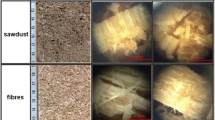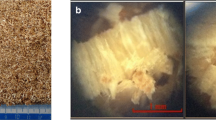Abstract
The wood industry generates some 12 million tons of waste in France, 60% of which basically stems from sawmills. The reuse of this waste in the most common construction materials (e.g., concrete) may offer a sustainable solution. In the literature, the optimization of composites formulations generally focuses on aggregates plant pretreatment regardless of classical optimization parameters and the implementation process that can afford to get a high strength composite. The work presented herein is intended to optimize the mix design of a mortar made from poplar wood by-products, without involving any pretreatment. The conventional mix design parameters (i.e., paste volume, W/C ratio) have been varied. An optimal implementation technique (i.e., extrusion) was used. The wood mortar mix designs have been optimized in order to obtain composites compliant with French standard NF EN 771-3/CN, with respect to criteria regarding both dimensional tolerance and mechanical strength for structural elements (i.e., above 8 MPa at 7 days).A mortar mix design, optimized by means of extrusion, has been used as a reference. Poplar wood particles have been introduced through substitution for the sand volume. Test results indicate that the blocks produced from two wood mortar mixes with 60 and 70% wood aggregate-for-sand substitution rates are in line with the normative requirements relative to dimensional tolerances and mechanical strength. This material compliance underscores the potential use of such blocks as load-bearing masonry elements, thus facilitating the building of structures with a limited environmental impact.
Similar content being viewed by others
References
centre regional de la propriete forestiere. http ://www.crpf.fr/(accessed 12.02.15)
Aigbomian EP, Fan M Development of wood-crete building materials from sawdust and waste paper. Constr Build Mater 40(2013):361–366
Fan M, KorNdikontar M, Zhou X, Ngamveng JN Cement-bonded composites made from woods: compatibility of wood and cement. Constr Build1 Mater 36(2012):135–140
Mohammed BS, Abdullahi M, Hoong CK (2014) Statistical models for concrete containing wood chipping as partial replacement to fine aggregate. Constr Build Mater 55:13–19
Lo CF, Biblis EJ (1968) Effect on the setting of southern pine-cement mixture. For Prod J 18:28–34
Yi MW, Tomita B, Hiramats Y et al (2002) Study of hydration behaviors of wood-cement mixtures: compatibility of cement mixed with wood fiber strand obtained by the water-vapor explosion process. J Wood Sci 48:365–373
Govin A, Peschard A, Guyonnet R (2006) Modification of cement hydration at early ages. Cem Concr Compos 28:12–20
Ashori A, Tabarsa T, Amosi F (2012) Evaluation of using waste timber railway sleepers in wood-cement. Constr Build Mater 27:126–129
Melo Filho JDA, Silva FDA, Tolêdo-Filho RD (2013) Degradation kinetics and aging mechanisms on sisal fiber cement composite systems. Cem Concr Compos 40:30–39
Tolêdo-Filho RD, Silva FDA, Fairbairn EMR, Filho JDAM (2009) Durability of compression molded sisal fiber reinforced mortar laminates. Constr Build Mater 23:2409–2420
Tonoli H, Joaquim GH, Arseneb A, Bilba MA, Savastano Jr K (2010) Performance and durability of cement based composites reinforced with refined sisal pulp. Mater Manuf Process 22:149–156
Peled A, Shah S (2003) Processing effects in cementitious composites: extrusion and casting. J Mater Civ Eng 15:192–199
Lecompte T, Perrot A, Subrianto A, Le Duigou A, Ausias G (2015) A novel pull-out device used to study the influence of pressure during processing of cement-based material reinforced with coir. Constr Build Mater 78:224–233
Huyen TLN, Queneudec T Kint M, Remond C, Chabbert B, Dheill R-M Saccharification of miscanthus x giganteus, incorporation of lignocellulosic by-product in cementitious matrix. C R Biologies 36(2011):837e1–837.e11
Kuder KG, Shah SP (2007) Tailoring extruded hpfrcc to be nailable. ACI Mater J 104:526–534
Coussot P, Ancey C (1999) Rheophysical classification of concentrated suspensions and granular pastes. Phys Rev 59:4445–4457
Toutou Z, Roussel N The squeezing test a tool to identify firm cement based materials rheological behavior and evaluate their extrusion ability. Cem Concr Res 35(2005):1891–1899
Khelifi H, Perrot A, Lecompte T, Rangeard D, Ausias G (2013) Prediction of extrusion load and liquid phase filtration during ram extrusion of high solid volume fraction pastes. Powder Technol 249:258–268
Savastano JH, Warden PG, Coutts RSP (2003) Mechanically pulped sisal as reinforcement in cementitious matrices. Cem Concr Compos 25:311–319
Naik TR, Friberg TS, Chun YM (2004) Use of pulp and paper mill residual solids in production of cellucrete. Cem Concr Res 34:1229–1234
Wei YM, Zhou YG, Tomita B (2000) Evaluation of wood species effects on compatibility and strength with ordinary portland cement. J Wood Sci 46:296–302
Dupain R, J. C (2009) Saint-Arroman.Granulats, sols. In: ciments et bétons : caractérisation des matériaux de génie civil par les essais en laboratoire, vol 1. CASTEILLA, France
Acknowledgements
The authors would like to thank the Nord-Pas de Calais Regional Council for financing this study. We are also grateful to the ASBOIS Company, BIALLAIS quarries and HOLCIM cement works in Lumbres for all their support throughout this research project.
Author information
Authors and Affiliations
Corresponding author
Rights and permissions
About this article
Cite this article
Ndong Engone, J.G., Vanhove, Y., Djelal, C. et al. Optimizing mortar extrusion using poplar wood sawdust for masonry building block. Int J Adv Manuf Technol 95, 3769–3780 (2018). https://doi.org/10.1007/s00170-017-1323-9
Received:
Accepted:
Published:
Issue Date:
DOI: https://doi.org/10.1007/s00170-017-1323-9




